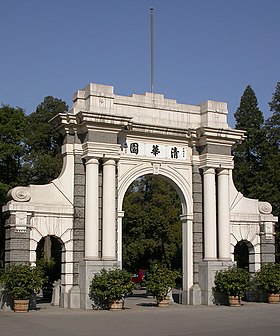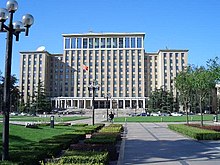This is an old revision of this page, as edited by Neo-Jay (talk | contribs) at 16:41, 25 October 2007 (my God! at least you should not remove it:Università Tsinghua). The present address (URL) is a permanent link to this revision, which may differ significantly from the current revision.
Revision as of 16:41, 25 October 2007 by Neo-Jay (talk | contribs) (my God! at least you should not remove it:Università Tsinghua)(diff) ← Previous revision | Latest revision (diff) | Newer revision → (diff) For other uses, see National Tsing Hua University.40°00′00″N 116°19′36″E / 40.00000°N 116.32667°E / 40.00000; 116.32667
| 清华大学 | |
| File:Tsinghua Emblem.jpg | |
| Motto | 自強不息, 厚德載物 (Self-discipline and Social Commitment) |
|---|---|
| Type | Public |
| Established | Founded in 1911 |
| President | Gu Binglin (顾秉林) |
| Academic staff | 2,857 |
| Undergraduates | 13,788 |
| Postgraduates | 17,998 |
| Location | |
| Campus | Urban, 405.9 ha |
| Flower | Redbud and Lilac |
| Colors | Purple and White |
| Website | www.tsinghua.edu.cn English |
Tsinghua University (THU; simplified Chinese: 清华大学; traditional Chinese: 清華大學; pinyin: Qīnghuá Dàxué), is a university in Beijing, China. It is regarded as one of the best and most selective universities in China. Established in 1911 as a preparatory school for Chinese graduates pursuing further studies at American universities, the school expanded and offered four-year undergraduate and post-graduate programs in 1925. The preparatory program continued until 1949.
History
Tsinghua University was established in Beijing in 1911 on the site of a former royal garden belonging to a prince, and was funded by an indemnity which China paid the United States after the Boxer Rebellion. It was first a preparatory school for students later sent by the government to study in the United States. The faculty members for sciences were recruited by the YMCA from the United States and its graduates transferred directly to American schools as juniors upon graduation.
In 1925 the school established its College Department and started its research institute on Chinese Study.
In 1928 the authority officially changed its name to National Tsing Hua University(NTHU).
During the Second World War in 1937, Tsinghua University along with Peking University and Nankai University, merged to form Changsha Temporary University in Changsha, and later National Southwestern Associated University in Kunming of Yunnan province. After the war, Tsinghua moved back to Beijing and resumed its operation.
After the communist victory at the end of the Chinese Civil War in 1949 which led to the creation of the People's Republic of China (PRC), Tsinghua University's President Mei Yi-Qi, followed by some professors, went to Taiwan (which was not under the control of the PRC) where they established the National Tsing Hua Institute of Nuclear Technology in 1955, which later became National Tsing Hua University.

In 1952, the communist government regrouped the country's higher education institutions in an attempt to build a Soviet style system, with individual institutions tending to specialise in a certain field of study. Tsinghua University lost its law school, school of agriculture, school of sciences and humanities and became a polytechnic university. In many years following this regroup, the school was often referred to as the "MIT of China". But since the 1980s, the university began to incorporate a multidisciplinary system. As a result, a lot of schools were built and rebuilt. These included the School of Science, School of Economics and Management, School of Humanities and Social Sciences, School of Law, School of Public Administration, and the School of Art. Only two colleges charge tuition to its graduate students; the law school and the Academy of Arts and Design.
During the Cultural Revolution from 1966 to 1976, the university became a battlefield between different sects of Mao's Red Guards (China) and a stronghold of the radicals. It did not resume its normal operation until 1977 when the Cultural Revolution was officially put to an end.
Since 1977, the university has enjoyed rich government funding and policy support which greatly improved its facilities.
Since 1978, Tsinghua has flourished with the re-establishment of the departments in sciences, economics and management, and the humanities. The Tsinghua graduate school has been recognized nationally, ranking first in the National Evaluation of Graduate Schools. The School of Continuing Education makes the best use of modern information technologies, as well as the advanced educational resources at Tsinghua.
Present

Most Chinese university rankings place Tsinghua first in China. Known as MIT of China, Tsinghua has the best engineering and applied sciences programs in the nation. Peking Union Medical College of Tsinghua University is likewise the regarded as the best medical school in the country. Tsinghua's longtime rival Peking University is better known for natural sciences, social sciences, law, and liberal arts ,leading it to be often labeled the Harvard of China. Indeed, the schools' proximity to one another, specializations, and spirited rivalry approximate that of the situation amongst the two American schools.
Admission to Tsinghua is highly competitive. The majority of selected students are national scholars and among the brightest high school graduates in the country.
Many of China's top scientists, engineers, politicians and business leaders are among Tsinghua alumni. The current Chinese president, Hu Jintao, is a former Tsinghua student who graduated with a degree in hydraulic engineering in 1964.
There are voices of critique that nowadays, the university's top graduates are more likely to enroll at prestigious US university and research institutions.
As of 2003, Tsinghua University had 12 colleges and 48 departments, 41 research institutes, 35 research centers, and 167 laboratories, including 15 national key laboratories. In September 2006, Peking Union Medical College was renamed to Peking Union Medical College, Tsinghua University. The university offers 51 bachelor's degree programs, 139 master's degree programs and 107 Ph.D. programs. Recently, Tsinghua has become the first Chinese university to offer a Master of Laws program in American law, through a cooperative venture with the Temple University Beasley School of Law. The university is a member of LAOTSE, an international network of leading universities in Europe and Asia. Each year, the University celebrates the Intellectual Property Summer Institute in cooperation with Franklin Pierce Law Center of Concord, New Hampshire.
On April 12, 2007, Tsinghua University's School of Economics and Management became the first business school in the Chinese mainland to earn AACSB accreditation. Former Premier Zhu Rongji was the founding dean of the school.
The University's Institute of Nuclear and New Energy Technology is on a separate campus in a northern suburb of Beijing.
Tsinghua is the Chinese university where former United States Vice President Al Gore lectured at in his documentary, An Inconvenient Truth. Viewers can see the university lecture hall, with its well-known purple seats.
Campus
The campus of Tsinghua University is located in northwest Beijing, in the Haidian district which was designated for universities.
It is located on the former site of Qing Dynasty royal gardens and retains some Chinese-style landscaping as well as some traditional buildings, but many of its buildings are Western-style reflecting the American influence in its history. It is known throughout China for having one of the most beautiful campuses.
The university's architect T. Chuang, a 1914 graduate of the University of Illinois at Urbana-Champaign, modeled his designs for the quadrangle and auditorium of Tsinghua on the Illinois campus, specifically imitating Foellinger Auditorium, located on the quad at the University of Illinois.
University Traditions

Tsinghua stands out for its strong and unique traditions originated from its early days as a preparatory school for Chinese graduates to prepare for American universities. Traces of American influence can be seen in Tsinghua's school culture. Sports play a big role on campus life.
Tsinghua Alma Mater
Tsinghua's early alma mater (school anthem) was composed by an American instructor Miss Katherine E. Seelye:
Tsing Hua College Song
- O come and join our hearty song,
- As proudly here we stand;
- For Tsing Hua College let us sing,
- The best in all the land.
- We'll spread her fame and win a name,
- And put our foes to shame,
- If you don't agree, come on and see,
- And you will say the same, the same,
- And you will say the same.
- O Tsing Hua, fair Tsing Hua,our College bright!
- May we be loyal to the Purple and the White.
- O Tsing Hua, fair Tsing Hua, our College pure,
- We are loyal, We're faithful, we stand for you.
In 1923, another version of the school alma mater with lyrics in Chinese (by Prof. Wang Luan Xiang, a Chinese language professor of Tsinghua) was composed by Mrs. Zhang Hui Zhen and was well received by the students and faculty. The song was then adopted as the school's official Alma Mater.
Anniversary and Homecoming
The last Sunday of April is Tsinghua's anniversry and Homecoming (Xiao-Qing) Day.
School Flowers
School Colors
Purple and White
Tsinghua Fight Song
Cheer for old Tsinghua
Tsinghua must win.
Fight to the finish,
never give in.
You do your best, boys,
we'll do the rest, boys.
Fight for the victory, Rha, Rha, Rha!

The school cheer goes: Ri-ri-ri, Rah-rah-rah! Tsinghua, Tsinghua, Tsinghua ! Rah-rah-rah!
Tsinghua People
Main article: List of Tsinghua University peopleTsinghua University has produced many notable people.
Global Partnership
Tsinghua University has signed agreements with ACCA (Association of Chartered Certified Accountants), the renowned international accountancy body that offers Chartered Certified Accountant qualification worldwide, to train the new generation of professional accountants in China. Under the agreement, Tsinghua will develop the programme that under ACCA's syllabus for enabling China's young accounting students to join the ACCA professional exam scheme at a higher level. Tsinghua will also recognise the Oxford Brookes University BSc Applied Accounting degree, which has been successfully developed in conjunction with ACCA and which enables students who have completed two parts of the ACCA qualification to apply for the Oxford Brookes degree.(Please click: )
Alumni Associations
Tsinghua Alumni Association in Beijing
Tsinghua Alumni Association of Northern California
TsingHua Alumni Association in New York
Tsinghua Alumni Association of Georgia (USA)
Silicon Valley Tsinghua Network (SVTN)
Tsinghua Alumni Association in Germany
Tsinghua Alumni Association in Singapore
See also
- National Tsing Hua University
- Peking Union Medical College, Tsinghua University
- Institute of Nuclear and New Energy Technology
- Tsinghua Science Park
- High School attached to Tsinghua University
- Tsinghua clique
- Qinghuayuan
- Wudaokou
- SMTH BBS
- Education in the People's Republic of China
- Colleges and Universities of Beijing
References
- Melissa Mitchell (2007-02-15). "Global partnership aims to train 'exceptional' professional". UIUC News Service. Retrieved 2007-07-10.
External links
- Template:Zh icon Home Page
- Template:En icon Home Page
- Template:En icon Tsinghua University Library
- Template:Zh icon Tsinghua University News
- Template:En icon Tsinghua University News
- Template:Zh icon Tsinghua Alumni Association in Beijing
- Inter-University Program for Chinese Language Studies at Tsinghua University
| Association of East Asian Research Universities | |
|---|---|
| China Mainland | |
| Hong Kong | |
| Japan | |
| Korea | |
| Macau | |
| Taiwan | |